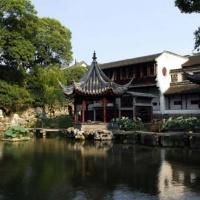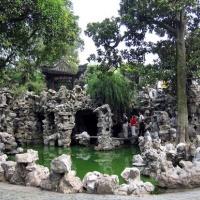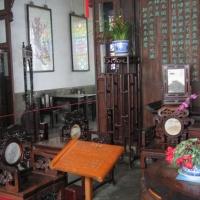Just up the street from the Humble Administrator's Garden, The Lion Grove (aka Lion Forest Garden, commonly called Shizilin in Chinese) was constructed in 1342 by the Monk Tian Ru and his disciples as a memorial to their master Zhi Zheng, Zhi Zheng, it appears, was some kind of cave dweller, and his last fixed address was called 'Lion Cliff, Tianmu Mountains, Zhejiang Province'. The garden has rockeries that evoke leonine forms, and a labyrinth of tunnels, the walls of which bear calligraphy from famous chisels. It's one hectare, on the dull side.
The Lion Forest Garden boasts its 22 buildings of varied types, which are embraced by valuable old trees. The Hall of Peace and Happiness, one of the main buildings in the garden, is a masterpiece of typical Mandarin Ducks' hall at Suzhou.



Divided in halves, the northern half of the hall differs from the southern half in many particular aspects, such as team-framing systems, furnishings, pavements, carvings, window desings and so on. With painted patterns and beam carvings and looking splendid in green and gold, the True Delight Pavilion (Zhenquting) in the royal style with the 'True Delight' tablet inscribed by the Qing Emperor Qianlong is a must-see in the garden and differs from the other plain and elegant gardens of Suzhou.
Other buildins include the Pointing at Cypress Trees Hall, the Asking Prunus Mume Pavilion and the Stone Boat, etc.
The Lion Grove is one of the four most famous gardens in Suzhou. Most tourists like to include this garden into their Suzhou tour packages.
See Top Ten famous Suzhou Gardens
